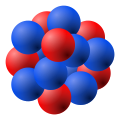Atomic nucleus: Difference between revisions
CSV import |
CSV import |
||
| Line 34: | Line 34: | ||
[[Category:Atomic physics]] | [[Category:Atomic physics]] | ||
[[Category:Nuclear physics]] | [[Category:Nuclear physics]] | ||
<gallery> | |||
File:Nucleus_drawing.svg|Diagram of an atomic nucleus | |||
File:Helium_atom_QM.svg|Quantum mechanical model of a helium atom | |||
File:Liquid_drop_model.svg|Liquid drop model of the atomic nucleus | |||
</gallery> | |||
Latest revision as of 01:57, 18 February 2025
Atomic Nucleus
The atomic nucleus is the small, dense region consisting of protons and neutrons at the center of an atom. Discovered in 1911 by Ernest Rutherford, the atomic nucleus is held together by the strong force, one of the four fundamental forces of nature.
Structure[edit]
The atomic nucleus is composed of two kinds of particles: protons and neutrons, collectively known as nucleons. Protons carry a positive electric charge, while neutrons are electrically neutral. The number of protons in the nucleus determines the atomic number and identifies the chemical element. The total number of protons and neutrons in the nucleus defines an atom's mass number.
Properties[edit]
The atomic nucleus is extremely dense and accounts for nearly all the mass of an atom. Despite its small size, the nucleus contains over 99.9% of an atom's mass but occupies only about one ten-thousandth of the total volume of the atom.
Nuclear Forces[edit]
The atomic nucleus is held together by the strong force, which overcomes the electromagnetic force that would otherwise cause the positively charged protons to repel each other. The strong force binds protons and neutrons together in the nucleus.
Nuclear Reactions[edit]
Changes in the atomic nucleus can result in nuclear reactions, including nuclear fission, in which a nucleus splits into two or more smaller nuclei, and nuclear fusion, in which two or more smaller nuclei combine to form a larger nucleus. These reactions release a large amount of energy, which is the basis for nuclear power and nuclear weapons.
See Also[edit]
References[edit]
<references />
-
Diagram of an atomic nucleus
-
Quantum mechanical model of a helium atom
-
Liquid drop model of the atomic nucleus


